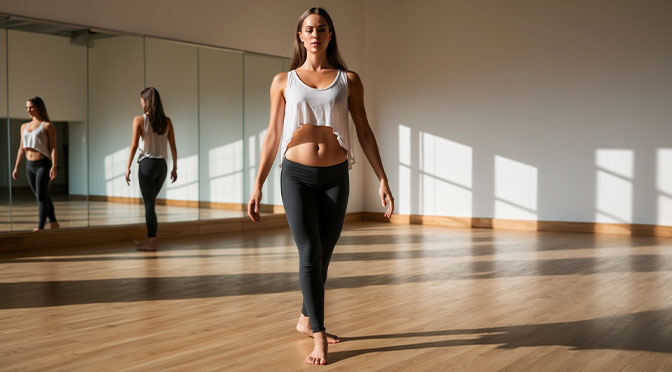Every breast tells a story—not through words, but through shape, texture, movement, and the way it exists in space. For writers of erotic literature, capturing this uniqueness is an art, one that requires moving beyond worn-out clichés like “pointy,” “full,” or “round,” and avoiding the awkward technicality of cup sizes. From a feminist perspective, it’s not about judging or idealizing bodies but presenting them as they are: individual expressions of humanity. This is about precision, respect, and the ability to put the physical into words without moralizing. Let’s explore this through examples—and offer tips on how you can weave it into your own prose.
Scene 1: The Barista at Dawn
Picture a small, crowded coffee shop just after sunrise. The scent of freshly ground coffee fills the air, the hiss of the espresso machine drowning out the murmur of customers. Behind the counter stands Lena, mid-twenties, with short, tousled hair she brushes from her forehead with a tired gesture. She wears a tight black T-shirt that stretches across her chest. Her breasts are small, slightly asymmetrical—the left sits a bit higher than the right. Her nipples show faintly through the fabric, not prominent but as subtle rises that shift with each breath. The areolas, barely visible beneath, are likely small and pale, matching her fair skin.
Lena isn’t here to be seen; she’s here to work. Yet her body tells of a life—perhaps long shifts, a form that adapts and asserts itself. Psychologically, she’s focused, mildly irritated by the morning rush, but carries a quiet confidence.
Tip for Writers: Don’t describe the breast in isolation—tie it to the person and their setting. Show how it behaves in motion or clothing for depth. Avoid valuing adjectives; “asymmetrical” says more than “pretty.” Use the character’s perspective: How does Lena feel in her body as she froths the milk?
Scene 2: The Dancer in the Studio
A large, light-filled room with mirrors lining the walls. It’s late afternoon, sunlight casting long shadows across the wooden floor. Aisha, a dancer in her early thirties, stands in the center, barefoot, wearing a loose tank top and leggings. Her skin is deep brown, glistening faintly with sweat from the past hour. Her breasts are full, hanging slightly with a natural weight that sways with each step. Her nipples, dark and wide, press through the thin fabric, the areolas beneath large and sharply defined, like two soft circles. Aisha’s posture is upright, shoulders relaxed—she’s aware of her body, not out of vanity but from the demands of her craft.
Psychologically, she exudes control and freedom. She dances not for an audience but for herself, and her breasts are part of that motion—not objects of desire, but elements of her physical presence.
Tip for Writers: Blend the body with the action. Aisha’s breasts aren’t static—they move with her, affect her balance. Describe texture (sweat, fabric) and shape (weight, outline) precisely, neutrally. Ask: How does the character experience their own body in this moment?
Scene 3: The Older Woman at the Beach
A windy afternoon by the sea. Waves crash, gulls screech overhead against a gray sky. Helga, a woman in her late sixties, sits on a blanket in the sand, dressed in a simple black swimsuit. Her hair is gray, tied in a loose bun, her skin wrinkled and sun-tanned. Her breasts are long and flat, hanging low over her stomach, with nipples narrow and pale pink, nearly blending into the light skin of her areolas, which spread wide and unevenly. She leans back on her elbows, gazing at the water with a faint smile.
Helga seems at ease, unbothered by others’ glances. Her body bears the marks of time and life—pregnancies, age, gravity—and she carries it with calm self-assurance.
Tip for Writers: Show the traces of life in the body without commentary. Helga’s breasts aren’t “old” or “young”—they just are, shaped by her history. Use details like skin texture or clothing interaction to highlight individuality. Let the character’s attitude shine—Helga’s ease makes her vivid.
How to Apply This in Your Prose
- Focus on the Specific: Instead of “round” or “full”—what exactly does this breast look like? Is it wide, narrow, does it hang, does it lift? Describe nipples and areolas with the same care as eyes or hands.
- Integrate Context: A breast doesn’t exist in a vacuum. How does it affect posture, clothing, movement? How does the character perceive it themselves?
- Stay Neutral, Yet Sensual: Avoid judgment, but don’t shy from intimacy. “The areolas were large and dark, with fine creases at the edges” is precise and evocative without being crude.
- Highlight Individuality: Every breast is unique—through shape, size, skin, scars, motion. Make that the strength of your description.
Writing Prompt
Write a scene where a character examines their own breasts in an intimate moment—perhaps before a mirror, after a shower, or while dressing. Describe them in detail, without judgment, and show how the character thinks or feels about them. Setting: a small bathroom with flickering light. Time: midnight. What makes these breasts unique, and how do they reflect the character’s personality or history?

